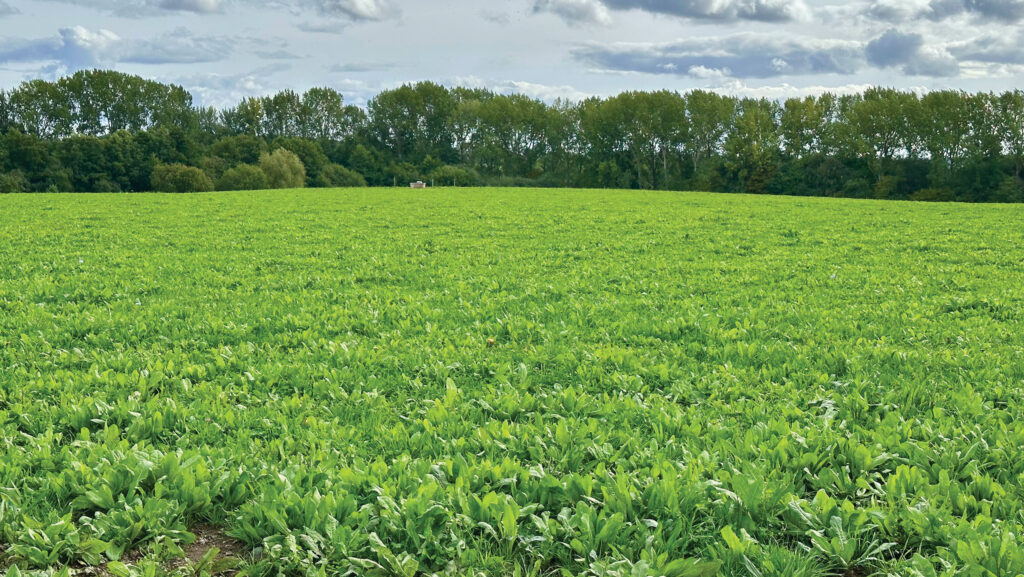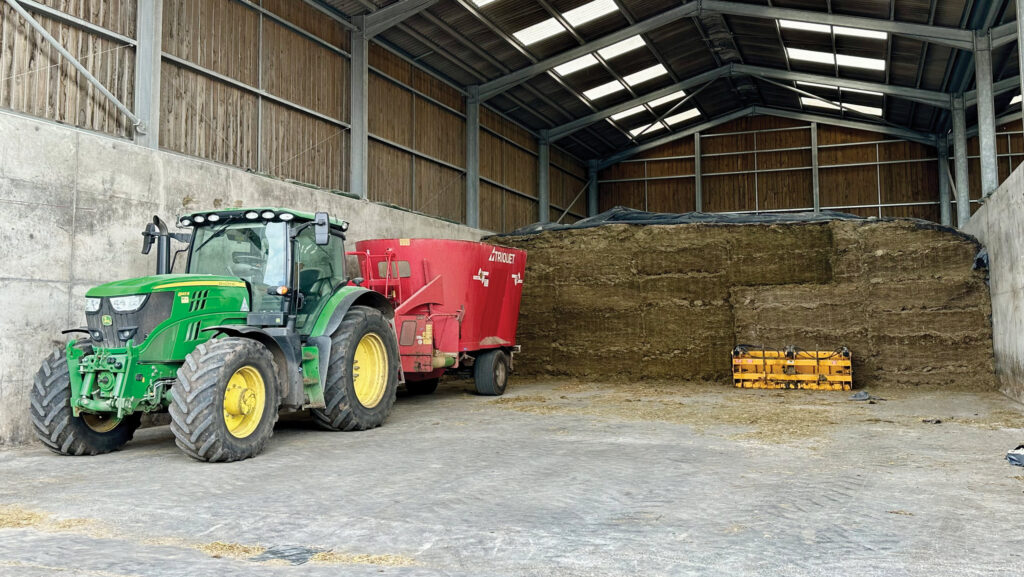Herbal v ryegrass-clover leys: Cattle performance on test
 Cattle at Bromstead Farms © MAG/Judith Tooth
Cattle at Bromstead Farms © MAG/Judith Tooth Performance of cattle grazing herbal leys and finished on herbal ley silage is “just as good” as those on a comparable ryegrass-clover diet, a farm trial has shown.
The results have given the team at ABP’s Shropshire demonstration farm confidence to grow a bigger acreage for their dairy beef enterprise.
See also: How efficiencies are driving down beef unit’s carbon footprint
Farm facts
- ABP Bromstead Farm, Newport, Shropshire
- 154ha with 134ha in production
- Grass and arable rotation
- Finishing 480-720 dairy-beef finished annually in batches of 120
- Calves bought in at 14 weeks old
- 300 store lambs bought in to finish off forage
Age at slaughter was almost identical in the two groups at Bromstead Farm, Newport, while average daily gain differed by just 50g/day, and average carcass weight by 5kg.
Meg Beswick, farm research lead at Bromstead Farm, says:
“We didn’t go into this thinking [the herbal ley] was going to blow it out of the water and be a hundred times better than grass, but to find the animals were no worse off and still performed well was a win.”
All grassland was renewed when ABP took on the farm 10 years ago. Wheat or oilseed rape are used as break crops in rotation with five- to seven-year ryegrass-clover leys.
Performance of cattle on herbal ley versus ryegrass-clover ley |
||
|
|
Herbal ley group (49 cattle) |
Ryegrass-clover group (69 cattle) |
|
Average daily gain (kg/day) |
1.18 |
1.13 |
|
Age at slaughter (months) |
17.45 |
17.43 |
|
Average carcass weight (kg) |
310.09 |
315.69 |
|
Source: ABP Bromstead Farm |
||
Trial preparation

Clover, chicory, plantain and grasses have persisted well in the herbal ley © MAG/Judith Tooth
For the trial, a 6ha (15-acre) field on sandy loam soils was sown with a GS4 herbal ley mix (16 species) in mid-August 2023.
A 7ha (17-acre) two-year-old ryegrass-clover ley was used for comparison, with two cuts of silage taken from each ley in June and August 2024.
Bromstead farm manager Andrew Macleod says: “The herbal ley grew like mad with no artificial fertiliser – and we’ve put none on since. In hindsight, we’d have cut for silage earlier, as it was a huge crop.”
In contrast, the ryegrass-clover ley received three applications of 125kg/ha of 25:5:5 plus sulphur.
One of the farm’s regular deliveries of about 120 dairy cross Angus calves was used for the trial. They arrived at 14 weeks of age, having been weaned onto a diet of feed nuts and straw.
Calves stayed on this ration for about two weeks before transitioning onto silage, supplemented with 2kg nuts/day.
They were turned out to grass in July 2024 until the grazing part of the trial began two months later, when they were eight months old.
Feeding management
At this point, cattle were randomly assigned into one of two groups: 49 were turned onto the herbal ley, and 69 onto the ryegrass-clover ley.
Fields were divided into 1.5ha (just under 4-acre) blocks and grazed rotationally from 10 September to 18 October 2024, with moves about every five days, according to sward measurements.
Once housed, cattle that had grazed the herbal ley moved onto herbal ley silage, while the group on the ryegrass-clover ley was fed ryegrass-clover silage.
Both groups were supplemented with wheat distillers, rolled barley and molasses to provide a 16% protein ration.
Cattle performance

One of Bromstead Farm’s regular intakes of 120 calves a year was used for the trial © MAG/Judith Tooth
In total, the trial lasted for 269 days covering the period from turnout to finishing. At point of slaughter, average daily gain, age at slaughter and carcass weight data were gathered.
“The ryegrass-clover ley group gained 50g/day less but finished a bit quicker,” says Meg, adding that, though randomly assigned to their groups, the herbal ley group weighed, on average, 10kg less than the ryegrass-clover ley group on arrival at the farm.
“So those 10kg behind had a bit of extra weight gain, but took a day or two longer to finish. For me, though, it’s how close they are in performance that’s impressive.”
Silage analysis

Silage is clamped in sheds and fed through a mixer wagon © MAG/Judith Tooth
There were, however, bigger differences in the feed value of the silages produced.
“The main variable was that the protein content of first-cut herbal ley silage was very low, at 8.5%, compared with the ryegrass-clover silage, which was 12.5%.
“So, we had to supplement the herbal ley ration with extra protein to meet nutritional requirement,” says Meg.
Second-cut herbal ley silage had a higher protein content than first cut, at 14.6%, which compared more favourably with the second-cut ryegrass-clover silage (15.8%).
“I think that’s down to the maturity of the clover in the ley at that point,” she suggests.
Analysis of herbal ley and ryegrass-clover silage in 2024 |
||||
|
Field cut |
Cutting date in 2024 |
Crude protein % |
Metabolisable energy % |
Dry matter content % |
|
Ryegrass-clover ley |
5 June |
12.5 |
11.2 |
31.5 |
|
Herbal ley |
8 June |
8.5 |
9.9 |
35.2 |
|
Herbal ley |
9 August |
14.6 |
9.3 |
45 |
|
Ryegrass-clover ley |
13 August |
15.8 |
10.1 |
52.3 |
|
Source: ABP Bromstead Farm (analysis by Trouw Nutrition) |
||||
Lessons learned
Andrew hopes to remedy this next year by applying a light, early dressing of nitrogen.
“We’ll add a bit of nitrogen plus sulphur to the herbal ley in spring, at about 125kg/ha, to get the clovers going, as that’s what’s controlling the protein level. But that’s still much lower than for the ryegrass-clover ley,” he says.
On top of that, the farm receives a GS4 payment.
“I can’t think of many drawbacks [to herbal leys] – it’s important to ensure you’re on top of the grazing because the chicory tends to bolt if you leave it too long.
“It can be hard to manage, but if you’re rotationally grazing, then you’ll keep on top of it.
“It might need topping to get the rough stuff out, and this year, some of the herbs within the mix have disappeared, but the clover, chicory, plantain and the grasses are good,” he says.
He admits he was sceptical about how the herbal ley would perform.
“The prospect of dealing with lots of plant species was a concern, but it went much better than I thought it would.
“The trial proved the herbal ley was no worse than a good ryegrass-clover mix – plus it’s good for the soil health and drainage because of the different rooting levels.”
Feed and forage crop establishment costs |
||||
|
Cattle group |
Overall feed cost |
Overall establishment costs |
Total cost |
Total cost difference |
|
Herbal ley |
£9,261 |
£4,596.86 |
£13,857.86 |
£947.33 |
|
Ryegrass-clover ley |
£8,511.30 |
£6,293.89 |
£14,805.19 |
|
|
Source: ABP Bromstead Farm Notes: Costs adjusted to enable comparison. Feed cost for 49 animals in each group across a 90-day period; cost of establishing and maintaining 7ha of herbal ley and 7ha ryegrass-clover ley. |
||||
Next steps for herbal leys
A further 11ha (27 acres) have just been sown to herbal leys (GS4), along with 3.5ha (9 acres) of red clover, chicory, plantain and grasses.
Performance of these two mixes will be compared for grazing and cutting for silage in 2026.
Soil health metrics will also be monitored, helped by the farm’s involvement in AHDB’s environmental baselining pilot, as well as cost of production.
“I wouldn’t be putting in more herbal leys if I thought there was going to be a problem. I’m going on the performance of the cattle,” says Andrew.
